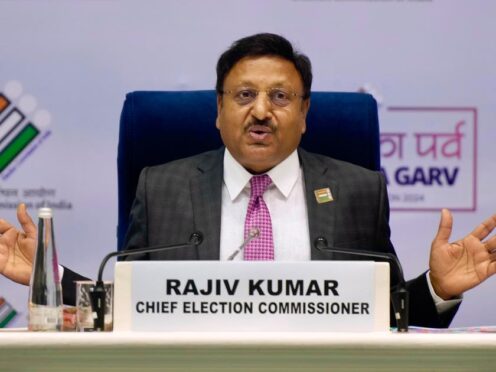
India has announced its six-week-long general elections will start on April 19, with most surveys predicting a victory for Prime Minister Narendra Modi and his Hindu nationalist Bharatiya Janata Party.
Voting in the world’s largest democracy will stretch over seven phases, with different states voting at different times and results will be announced on June 4.
Nearly one billion voters — more than 10% of the world’s population — will elect 543 members for the lower house of Parliament for a term of five years.

Mr Modi, who is seeking a third consecutive term, faces little challenge as the main opposition alliance of over two dozen regional parties led by the Indian National Congress party appears to be cracking, riven by rivalries, political defections and ideological clashes.
Analysts say the elections are likely to cement Mr Modi as one of India’s most enduring most consequential leaders who has sought to transform the country from a secular democracy into an avowedly Hindu nation.
Each election phase will last one day and several constituencies — spread across multiple states, densely populated cities and far-flung villages — will vote that day.
The staggered polling allows the government to deploy tens of thousands of troops to prevent violence and transport electoral officials and voting machines.
India has a first-past-the-post multiparty electoral system in which the candidate who receives the most votes wins.
Ahead of the polls, Mr Modi has been travelling across the country inaugurating new projects, making speeches and engaging with voters.
Support for the leader surged after he opened a Hindu temple in northern Ayodhya city in January, which many saw as the unofficial start of his election campaign because it fulfilled his party’s long-held Hindu nationalist pledge.
The 73-year-old first swept to power in 2014 on promises of economic development, presenting himself as an outsider cracking down on the political elite.
Since then, he has grown increasingly popular and mixed religion with politics in a formula that has resonated deeply with the country’s majority Hindu population even if it undermines India’s secular roots.
The elections come as India’s clout on the global stage has risen under Mr Modi, thanks to its large economy and partly because it is seen as a counterweight to a rising China.
Critics say that nearly a decade of Mr Modi’s rule has been marked by rising unemployment even as its economy swells, attacks by Hindu nationalists against the country’s minorities, particularly Muslims, and a shrinking space for dissent and free media.
The opposition says a win by Mr Modi’s party could threaten India’s status as a secular, democratic nation.
A victory for Mr Modi’s BJP would follow a 2019 electoral triumph, when it secured an absolute majority with 303 parliamentary seats against 52 held by the Congress party.

Enjoy the convenience of having The Sunday Post delivered as a digital ePaper straight to your smartphone, tablet or computer.
Subscribe for only £5.49 a month and enjoy all the benefits of the printed paper as a digital replica.
Subscribe